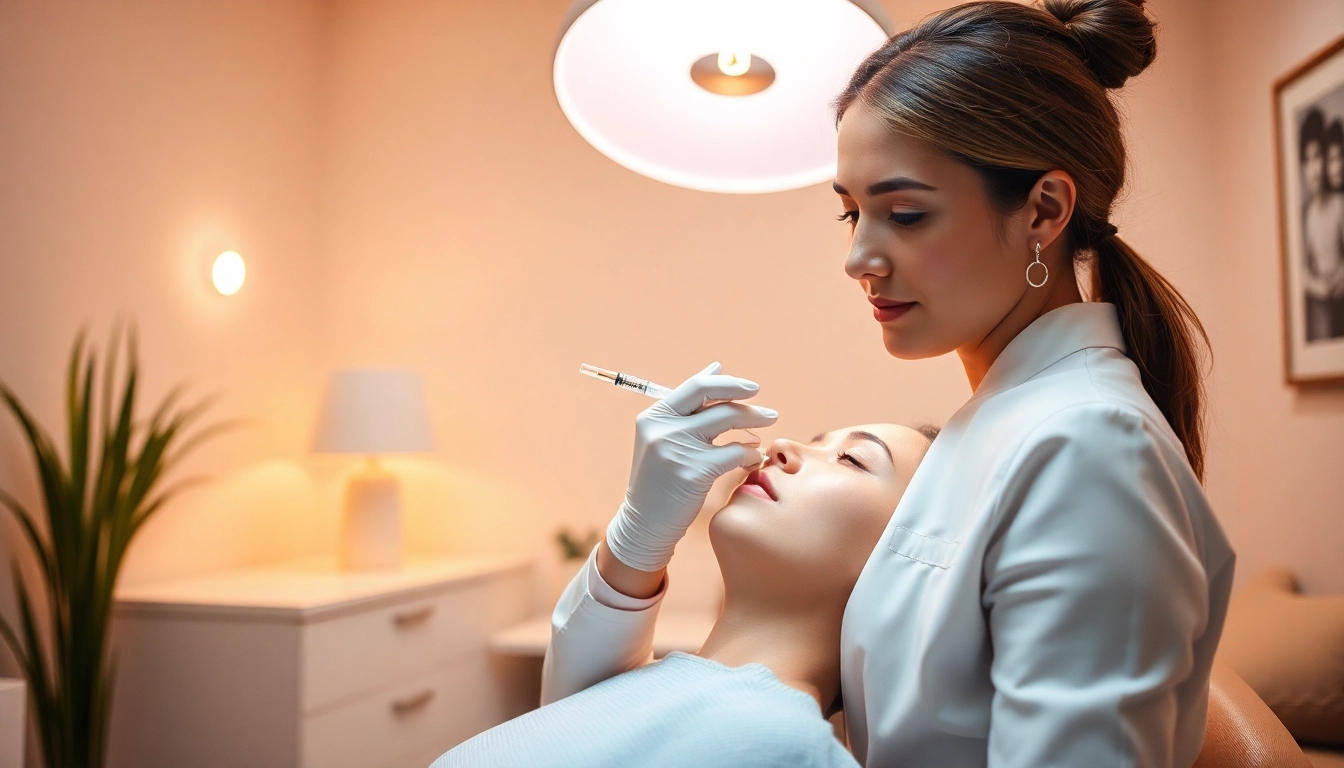Understanding Botox Behandlung
Botox Behandlung, or Botox treatment, has gained immense popularity as a method for reducing wrinkles and enhancing facial aesthetics. With the increasing demand for non-surgical cosmetic procedures, understanding the nuances of Botox treatment is essential for both potential patients and practitioners. This guide delves into the workings of Botox, its common uses, and what potential candidates need to know before deciding on this procedure. For tailored information regarding your individual needs, visit Botox Behandlung.
What is Botox and How It Works?
Botox is a brand name for Botulinum toxin, a neurotoxic protein produced by the bacterium Clostridium botulinum. When used in controlled doses, it has several therapeutic benefits. Primarily, Botox works by blocking nerve signals to specific muscles, effectively causing temporary paralysis in those muscles. This action significantly reduces the ability to contract, smoothing out dynamic wrinkles typically caused by facial expressions, such as frowning or squinting. The treatment typically lasts between three to six months, after which muscle activity gradually returns.
Common Uses of Botox Behandlung
Botox treatment is widely recognized for its aesthetic applications, particularly in combating the signs of aging. Common target areas include:
- Forehead lines
- Crow’s feet (the lines around the eyes)
- Frown lines
- Bunny lines (on the nose)
Beyond cosmetic benefits, Botox is also used in various medical applications. These applications include:
- Treatment of chronic migraines
- Management of excessive sweating (hyperhidrosis)
- Relief from muscle spasms and certain neurological conditions
- Treatment of temporomandibular joint disorders (TMJ)
- Eye disorders such as strabismus (crossed eyes)
Who is a Good Candidate?
Good candidates for Botox treatment typically include individuals who are in good overall health and have realistic expectations about the results. Ideal candidates may include:
- Individuals experiencing moderate to severe dynamic wrinkles
- Those looking for a minimally invasive solution
- Individuals seeking relief from medical conditions treatable by Botox
However, people who are pregnant or nursing, have certain neuromuscular disorders, or are allergic to albumin should consult their healthcare provider before proceeding with Botox treatment.
Benefits of Botox Behandlung
Immediate Cosmetic Advantages
The most immediate benefit of Botox treatment is its effectiveness as a cosmetic enhancer. Patients often notice a remarkable reduction in the appearance of fine lines and wrinkles soon after the procedure. The effects become more pronounced about two weeks post-treatment, offering a rejuvenated appearance that can enhance an individual’s confidence. Additionally, many patients enjoy the non-invasive nature of the treatment, which typically requires minimal downtime.
Medical Applications Beyond Aesthetics
Beyond its cosmetic use, Botox has proven essential in various medical fields. Patients suffering from chronic migraines may find relief through Botox injections, as they can prevent the release of chemicals that lead to headache pains. Similarly, individuals with hyperhidrosis benefit from Botox’s ability to block nerve signals responsible for excessive sweating, allowing for a more comfortable daily experience. These medical benefits underscore that Botox treatment is a versatile tool, not limited to aesthetics alone.
Long-term Effects and Maintenance
While many treatments provide only temporary results, Botox can create a cumulative effect over time. Regular use can lead to a longer-lasting smoothing of the skin, as the repeated relaxation of targeted muscles may prevent the development of new lines and wrinkles. To maintain desired results, patients typically schedule follow-up treatments every three to six months. This routine can lead to sustained youthfulness and vitality without requiring more invasive surgical procedures.
Cost Factors for Botox Behandlung
What Influences Pricing?
The cost of Botox treatment varies significantly depending on multiple factors including the provider’s expertise, geographic location, and the area being treated. Generally, prices can range from $300 to $600 per session for standard facial areas, but clusters of injections or larger treatment areas will increase the overall cost. The dosage required also plays a critical role; more complex cases may necessitate higher volumes, leading to higher expenses.
Insurance and Payment Options
Most insurance plans view Botox primarily as a cosmetic procedure, thereby excluding it from coverage. However, when Botox is administered for medical purposes—such as chronic migraines—patients may qualify for insurance reimbursement. It’s crucial for patients to check with their insurance providers regarding specific coverage details and to discuss payment plans or financing options with their treatment centers.
Comparing Costs with Other Treatments
When evaluating the cost of Botox treatment, it’s beneficial to compare it against other cosmetic procedures. For instance, dermal fillers can range from $600 to $1,200 per treatment session, generally lasting longer than Botox but often requiring higher costs. Moreover, surgical procedures such as facelifts can start at several thousand dollars, with extended recovery times that Botox does not necessitate. This price comparison illustrates that Botox often provides a cost-effective approach to maintaining a youthful appearance.
Preparing for Your Botox Behandlung
Pre-Treatment Consultation Steps
Preparation for Botox treatment begins with a thorough consultation. During this session, potential patients should openly discuss their medical history, cosmetic goals, and any concerns they may have. Practitioners may evaluate the treatment areas to devise a personalized plan tailored to the patient’s unique anatomy and preferences. A few days prior to treatment, patients may be advised to avoid blood-thinning medications or alcohol to minimize the risk of bruising.
What to Expect on Treatment Day
On the day of treatment, the actual injection process is relatively quick and often can be completed within 15 to 30 minutes. Patients are typically seated in a comfortable chair, and the targeted areas are marked for precision. A topical anesthetic may be applied to alleviate discomfort during injections, though many experience minimal pain due to the fine gauge needles used. Once completed, patients can often resume daily activities immediately.
Post-Treatment Care and Guidelines
Post-treatment care is critical for achieving optimal results. Patients are usually advised to avoid strenuous exercise, excessive sun exposure, and lying flat for several hours post-injection to prevent the spread of the toxin. It’s common to experience mild swelling or bruising at the injection sites, which typically resolves in a few days. Keeping the treated areas clean and avoiding facial treatments for at least 24 hours is recommended.
Addressing Common Concerns and Myths
Is Botox Safe? Understanding Risks
While Botox is widely considered safe when performed by qualified professionals, there are inherent risks as with any medical procedure. Potential side effects can include headache, nausea, flu-like symptoms, and localized reactions such as swelling or pain. Severe complications are rare but can occur. Patients should ensure that their providers are certified and experienced in this specific treatment.
Debunking Myths About Botox Behandlung
Numerous myths and misconceptions about Botox persist, often leading to misunderstandings regarding its use. Common myths include the belief that Botox will give an unnatural appearance or that it is only for the elderly. In reality, Botox can be administered subtly, and many patients in their 30s and 40s utilize it as a preventative measure against aging signs—indicating that early treatment can contribute to long-term benefits.
Real Patient Testimonials and Experiences
Many patients report satisfaction with Botox treatment, highlighting improvements not only in their appearance but also in self-esteem. Adjustments in treatment can be made based on previous experiences, allowing patients to manage their aesthetic goals actively. Testimonials often reveal that patients appreciate the ease of the treatment process, its minimal downtime, and the immediate visible results.




